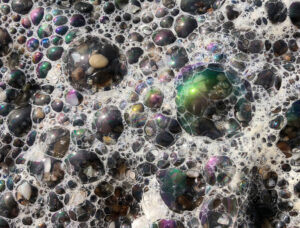As we enter the last weeks of the dry season and await the return of the rains that will put some life back into our parched hillsides, I’m still living off the remembered images of our incredible, extended spring, with its profuse and sustained palette of wildflowers lasting from early February through late June. The glorious showers of clarkias and Ithuriel’s spears still going strong out at Morgan Territory in mid-June were indeed a thrilling ‚Äúfarewell to spring‚Äù for this grateful hiker.
It now appears that the same climate pattern that brought the prolonged November through May soaking (and resulting wildflower extravaganza) to central and southern California is responsible for another, more troubling condition: diminished upwelling along our coast. Upwelling is the annual spring and summer phenomenon that brings nutrient-rich colder water up from the ocean depths. As we report on page 6, the strong northerly winds that normally produce this upwelling didn’t show up, leading to near-shore water temperatures five to seven degrees above normal. No upwelling means drastically reduced phytoplankton, which leads to less zooplankton, which means fewer fish, starving seabirds, and so on up the marine food chain.
What’s going on here? Scientists are frankly puzzled; such warmer water conditions are usually associated with El Ni√±o years, but the conditions that typically spawn El Ni√±os in the southern hemisphere weren’t present this year. Is it a sign of global warming? Not necessarily; scientists think this may be a contributing factor, but not the whole story, since climate change is a gradual phenomenon, and this year’s change was quite sudden. Is it just an anomaly? We’ll have to wait until next year to find out, and hope that the populations of Cassin’s auklets, rockfish, and other impacted species can survive and rebound.
Now that we can get our food and other necessities from all over the globe, we are less likely to be directly affected in the short run by dramatic changes in the surrounding environment. But we would do well to listen to (and fund!) the scientists who track ocean temperatures and wildlife populations. And strive not to add more insults (offshore oil drilling, sonar testing, overfishing, etc.) to the lives of our already-stressed marine neighbors.
At Bay Nature, we are constantly challenged to straddle this line between celebrating the myriad natural wonders of our region and warning about the threats to their survival. We can revel in the unprecedented sight of grunion mating on Crown Beach in Alameda while at the same time voicing concern about the anomalous appearance of a Southern California fish in the Bay. As we round out our fifth year of publishing Bay Nature, we promise to continue bringing you information to help decipher the complex interactions that make our region tick, both because it’s endlessly fascinating and because it’s absolutely essential to our continued ability to survive as a vibrant urban culture in the midst of natural beauty.




